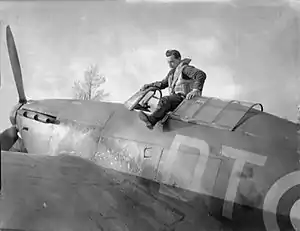Howard Blatchford
Howard Peter "Cowboy" Blatchford, DFC (25 February 1912 – 3 May 1943) was a flying ace, who achieved the first Canadian victory in World War II.
Howard Peter Blatchford | |
|---|---|
 Flight Lieutenant H P "Cowboy" Blatchford of No. 257 Squadron RAF climbing out of his Hawker Hurricane Mark I at RAF Martlesham Heath, Suffolk. | |
| Birth name | Howard Peter Blatchford |
| Born | 25 February 1912 Edmonton, Alberta, Canada |
| Died | 3 May 1943 (aged 31) Amsterdam, German-occupied Netherlands |
| Allegiance | United Kingdom |
| Service/ | Royal Air Force |
| Years of service | 1936–1943 |
| Rank | Wing Commander |
| Unit | No. 41 Squadron RAF No. 212 Squadron RAF No. 17 Squadron RAF No. 257 Squadron RAF Digby Wing Coltishall Wing |
| Battles/wars | World War II |
| Awards | Distinguished Flying Cross |
Blatchford was born in Edmonton, Alberta on 25 February 1912, and enlisted in the Royal Air Force in February 1936.[1] He was posted to No. 41 Squadron RAF in early 1937. In April 1940 he was posted to No. 212 Squadron RAF, flying photo-reconnaissance operations. In June he joined the Photographic Development Unit as a flight commander, later transferring to No. 17 Squadron RAF in September, flying Hawker Hurricanes. He soon joined No. 257 Squadron RAF, under the command of Squadron Leader Robert Stanford Tuck.[2]
In December 1940, Blatchford was awarded the Distinguished Flying Cross:
Flight Lieutenant Howard Peter BLATCHFORD (37715), No. 257 Squadron. In November, 1940, this officer was the leader of a squadron which destroyed eight and damaged a further five enemy aircraft in one day. In the course of the combat he rammed and damaged a hostile fighter when his ammunition was expended, and then made two determined head-on feint attacks on enemy fighters, which drove them off. He has shown magnificent leadership and outstanding courage.[3]
Blatchford became commanding officer of No. 257 Squadron RAF in July 1941.[4] He was promoted to wing commander in September that year, becoming wing leader of the Digby Wing. On September 23, 1941, John Gillespie Magee, the author of the famous flying poem "High Flight," arrived at Digby for his first operational posting, on RCAF 412 Squadron.[5] On October 12, 1941, Magee's squadron moved from the Digby aerodrome to the nearby RAF Wellingore, from which he was operating when he died. Blatchford finished his tour of duty in April 1942, returning to operations in February 1943 as wing leader of the Coltishall Wing.
Leading the Coltishall Wing to escort bombers attacking a power station in Amsterdam, Blatchford was shot down and killed in action on 3 May 1943 by Obfw. Hans Ehlers of II Gruppe, Jagdgeschwader 1. His body was never found. He is commemorated on the Air Forces Memorial at Runnymede.[6]
At the time of his death, Blatchford had claimed five aircraft shot down, three shared aircraft shot down, three "probables", four damaged and one shared damaged.[7]
References
- http://www.cieldegloire.com/003_blatchford_h_p.php
- http://acesofww2.com/can/aces/blatchford/
- "No. 35009". The London Gazette. 6 December 1940. p. 6938.
- http://www.rcaf.com/archives/archives_general/aces/aces_ab.htm
- Stephen M. Fochuk, "Maggie's War - John Gillespie Magee's One and Only Time he engaged the Luftwaffe", Air Force Magazine, Vol. 41, No. 3, 15 December 2017, p. 44
- http://www.cwgc.org/find-war-dead/casualty/1529953
- "Archived copy". Archived from the original on 18 January 2009. Retrieved 5 September 2009.CS1 maint: archived copy as title (link)
- Aces High- C.Shores & C.Williams (Grub Street 1991) page 133.
- "WWI Aces of Canada". www.theaerodrome.com. Retrieved 14 June 2008.